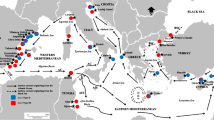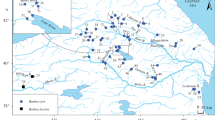Abstract
The alternation of glacial and interglacial events during the Pleistocene has produced changes in species distribution ranges leading to bottlenecks and alterations of patterns of gene flow. The European stalked barnacle, Pollicipes pollicipes, is a sessile pedunculate cirripede that inhabits the rocky intertidal frame, from Senegal to the northwestern coast of France. In this work, we have analyzed a fragment of the mitochondrial gene cytochrome c oxidase subunit I for 569 individuals of P. pollicipes in order to investigate whether the shifts in climatic conditions that occurred during the Pleistocene influenced the current pattern of distribution of genetic variation of P. pollicipes. A pre-last glacial maximum pattern of demographic expansion was found, in concordance with many other North Atlantic marine species. On the other hand, three potential glacial refugia were identified: North African coasts, northwestern Iberian Peninsula and English Channel/Brittany.


Similar content being viewed by others
References
Allendorf FW, Luikart G (2007) Conservation and the genetics of populations. Blackwell, Malden
Avise JC (2000) Phylogeography: the history and formation of species. Harvard University Press, Cambridge, MA
Barnes M (1996) Pedunculate cirripedes of the genus Pollicipes. Oceanogr Mar Biol Annu Rev 34:303–394
Barnes M, Barnes H (1962) The distribution and general ecology of Balanus balanoides together with some observations on Balanus improvisus in the waters around the coasts of Denmark, southern Sweden and northeast Germany. Lund Universitets Arskrift N.F. AVD, vol 58
Chevolot M, Hoarau G, Rijnsdorp AD, Stam WT, Olsen JL (2006) Phylogeography and population structure of thornback rays (Raja clavata L., Rajidae). Mol Ecol 15:3693–3705
Clement M, Posada D, Crandall KA (2000) TCS: a computer program to estimate gene genealogies. Mol Ecol 9:1657–1660
Coyer JA, Diekmann O, Serrão EA, Procaccini G, Milchakova N, Pearson GA et al (2004) Population genetics of dwarf eelgrass Zostera noltii throughout its biogeographic range. Mar Ecol-Prog Ser 281:51–62
Crisp DJ, Bourget E (1985) Growth in barncales. Adv Mar Biol 22:199–244
Cruz T (1993) Growth of Pollicipes pollicipes (Gmelin, 1970) (Cirripedia, Lepadomorpha) on the SW coast of Portugal. Crustaceana 65:151–158
Drummond AJ, Rambaut A (2007) BEAST: bayesian evolutionary analysis sampling trees. BMC Evol Biol 7:214
Duran S, Palacín C, Becerro MA, Turon X, Giribet G (2004) Genetic diversity and population structure of the commercially harvested sea urchin Paracentrotus lividus (Echinodermata, Echinoidea). Mol Ecol 13(11):3317–3328
Estoup A, Largiadèr CR, Perrot E, Chourrout D (1996) Rapid one-tube DNA extraction for reliable PCR detection of fish polymorphic marker and transgenes. Mol Mar Biol Biotechnol 5(4):295–298
Excoffier L, Smouse PE, Quattro JM (1992) Analysis of molecular variance inferred from metric distances among DNA haplotypes: application to human mitochondrial DNA restriction data. Genetics 131:479–491
Excoffier L, Laval G, Schneider S (2005) Arlequin ver. 3.0: an integrated software package for population genetics data analysis. Evol Bioinform Online 1:47–50
Fu YX (1997) Statistical test of neutrality of mutations against population growth, hitch-hiking and biological selection. Genetics 147:915–925
Garrick RC, Dyer RJ, Beheregaray LB, Sunnucks P (2008) Babies and bathwater: a comment on the premature obituary for nested clade phylogeographical analysis. Mol Ecol 17:1401–1403
Gómez A, Hughes RN, Wright PJ, Carvalho GR, Lunt DH (2007) Mitochondrial DNA phylogeography and mating compatibility reveal marked genetic structuring and speciation in the NE Atlantic bryozoan Celleporella hyalina. Mol Ecol 16:2173–2188
Hall TA (1999) BioEdit: a user-friendly biological sequence alignment editor and analysis program for Windows 95/98/NT. Nucleic Acid Symp Ser 41:95–98
Hartl DL, Clark AG (1997) Principles of population genetics. Sinauer, Sunderland, MA
Hewitt GM (1996) Some genetic consequences of ice ages, and their role in divergence and speciation. Biol J Linn Soc Lond 58:247–276
Hewitt GM (2004) Genetic consequences of climatic oscillations in the Quaternary. Phil Trans R Soc B 359:183–195
Hoarau G, Coyer JA, Veldsink JH, Stam WT, Olsen JL (2007) Glacial refugia and recolonization pathways in the brown seaweed Fucus serratus. Mol Ecol 16:3606–3616
Jolly MT, Viard F, Gentil F, Thiébaut E, Jollivet D (2006) Comparative phylogeography of two coastal polychaete tubeworms in the Northeast Atlantic supports shared history and vicariant events. Mol Ecol 15:1841–1855
Kellaway GA, Redding HH, Shephard-Thorn ER, Destombes JP (1975) The quaternary history of the English Channel. Phil Trans R Soc A 279:189–218
Luttikhuizen PC, Drent J, Baker AJ (2003) Disjunct distribution of highly diverged mitochondrial lineage clade and population subdivision in a marine bivalve with pelagic larval dispersal. Mol Ecol 12:2215–2229
Marko PB (2004) ‘What’s larvae got to do with it?’ Contrasting patterns of postglacial population structure in two benthic marine gastropods with identical larval dispersal capabilities. Mol Ecol 13:597–611
McDonald J, Kreitman M (1991) Adaptive protein evolution at the Adh locus in Drosophila. Nature 351:652–654
Molares J (1993) Estudio del ciclo biológico del percebe (Pollicipes cornucopia Leach) de las costas de Galicia. Alimentaria 248:9–71
Molares J, Tilves F, Quintana R, Rodríguez S, Pascual C (1994) Gametogenesis of Pollicipes cornucopia (Cirripedia: Scalpellomorpha) in north-west Spain. Mar Biol 120:553–560
Olsen JL, Stam WT, Coyer JA, Reusch TBH, Billingham M, Boström C et al (2004) North Atlantic phylogeography and large-scale population differentiation of the seagrass Zoostera marina L. Mol Ecol 13:1923–1941
Petit RJ, El Mousadik A, Pons O (1998) Identifying populations for conservation on the basis of genetic markers. Cons Biol 12:844–855
Pfenninger M, Posada D (2002) Phylogeographic history of the land snail Candidula unifasciata (Helicellinae, Stylommatophora): fragmentation, corridor migration, and secondary contact. Evolution 56(9):1776–1788
Posada D, Crandall K (1998) MODELTEST: testing the model of DNA substitution. Bioinformatics 14:817–818
Posada D, Crandall K, Templeton AR (2000) GEODIS: a program for the cladistic nested analysis of the geographical distribution of genetic haplotypes. Mol Ecol 9:487–488
Provan J, Bennett KD (2008) Phylogeographic insights into cryptic glacial refugia. Trends Ecol Evol 23(10):564–571
Provan J, Wattier RA, Maggs CA (2005) Phylogeographic analysis of the red seaweed Palmaria palmata reveals a Pleistocene marine glacial refugium in the English Channel. Mol Ecol 14:793–804
Quinteiro J, Rodríguez-Castro J, Rey-Méndez M (2007) Population genetic structure of the stalked barnacle Pollicipes pollicipes (Gmelin, 1789) in the northeastern Atlantic: influence of coastal currents and mesoscale hydrographic structures. Mar Biol 153:47–60
Ramos-Onsins SE, Rozas J (2002) Statistical properties of new neutrality test against population growth. Mol Biol Evol 19(1):2092–2100
Rozas J, Sánchez-DelBarrio JC, Messeguer X, Rozas R (2003) DnaSP, DNA polymorphism analyses by the coalescent and other methods. Bioinformatics 19:2496–2497
Stamatis C, Triantafyllidis A, Moutou KA, Mamuris Z (2004) Mitochondrial DNA variation in Northeast Atlantic and Mediterranean populations of Norway lobster, Nephrops norvergicus. Mol Ecol 13(6):1377–1390
Svendsen JI, Alexanderson H, Astakhov VI et al (2004) Late Quaternary ice sheet history of northern Eurasia. Quat Sci Rev 23:1229–1271
Tajima F (1993) Simple methods for testing molecular clock hypothesis. Genetics 135:599–607
Tamura K, Nei M (1993) Estimation of the number of nucleotide substitutions in the control region of mitochondrial DNA in humans and chimpanzees. Mol Biol Evol 10:512–526
Tamura K, Dudley J, Nei M, Kumar S (2007) MEGA4: molecular evolutionary genetics analysis (MEGA) software version 4.0. Mol Biol Evol 24:1596–1599
Templeton A (2001) Using phylogeographic analyses of gene trees to test species status and processes. Mol Ecol 10:779–791
Templeton A, Boerwinkle E, Sing CF (1987) A cladistic analysis of phenotypic associations with haplotypes inferred from restriction endonuclease mapping. I. Basic theory and an analysis of Alcohol Dehydrogenase activity in Drosophila. Genetics 117:343–351
Templeton A, Crandall KA, Sing C (1992) A cladistic-analysis of phenotypic associations with haplotypes inferred from restriction endonucleases mapping and DNA-sequence data. Genetics 132:619–633
Thompson JD, Higgins DG, Gibson TJ (1994) CLUSTAL W: improving the sensitivity of progressive multiple sequence alignment through sequence weighting, position specific gap penalties and weight matrix choice. Nucl Acids Res 22:4673–4680
Van Syoc RJ (1994) Genetic divergence between subpopulations of the eastern Pacific goose barnacle Pollicipes elegans: mitochondrial cytochrome c subunit 1 nucleotide sequences. Mol Mar Biol Biotechnol 3(6):338–346
Van Syoc RJ (1995) Barnacle mitochondrial DNA: determining genetic relationship among species of Pollicipes. In: Schram FR, Høeg JT (eds) New frontiers in barnacle evolution. Crustacean Issues, Rotterdam, pp 269–296
Wares JP (2001) Patterns of speciation inferred from mitochondrial DNA in North American Chthmalus (Cirripedia: Balanomorpha: Chthmaloidea). Mol Phylogenet Evol 18:104–116
Wares JP, Cunningham CW (2001) Phylogeography and historical ecology of the North Atlantic intertidal. Evolution 55(12):2455–2469
Acknowledgments
Samples were collected with the help of Ramón Riveiro, Jorge L. Alcázar and other anonymous collaborators. We want to thank Dr. Galice Hoarau for precious help in focusing the paper. Dr. David Posada helped us with the NCA. Prof. Francis Juanes revised the article and corrected the English. We also want to thank two anonymous reviewers for helpful comments. This study has been financially supported by the Xunta de Galicia (Spain), Grant SV-05-XUNTA-1.
Author information
Authors and Affiliations
Corresponding author
Additional information
Communicated by M. I. Taylor.
Electronic supplementary material
Below is the link to the electronic supplementary material.
Rights and permissions
About this article
Cite this article
Campo, D., Molares, J., Garcia, L. et al. Phylogeography of the European stalked barnacle (Pollicipes pollicipes): identification of glacial refugia. Mar Biol 157, 147–156 (2010). https://doi.org/10.1007/s00227-009-1305-z
Received:
Accepted:
Published:
Issue Date:
DOI: https://doi.org/10.1007/s00227-009-1305-z




